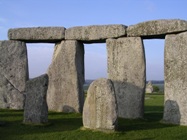New discovery in Stonehenge bluestone mystery

Stonehenge
22 February 2011
The source of the bluestones at Stonehenge has long been a subject of fascination and considerable controversy. One type of bluestone, the so-called ‘spotted dolerite’, was convincingly traced to the Mynydd Preseli area in north Pembrokeshire in the early 1920s.
However, the sources of the other bluestones - chiefly rhyolites (a type of rock) and the rare sandstones remained, until recently, unknown.
Now geologists at Amgueddfa Cymru – National Museum Wales have further identified the sources of one of the rhyolite types, which also provides the opportunity for new thoughts on how the stones might have been transported to the Stonehenge area.
Their findings are published in the March 2011 edition of the Journal of Archaeological Science.
Dr Richard Bevins, Keeper of Geology at Amgueddfa Cymru, in partnership with Dr Rob Ixer, from the University of Leicester and Dr Nick Pearce of Aberystwyth University, have been working on the rhyolite component of the bluestones, which leads them to believe it is of Welsh origin.
Through standard petrographical techniques combined with sophisticated chemical analysis of samples from Stonehenge and north Pembrokeshire using laser ablation induction coupled mass spectrometry at Aberystwyth University, they have matched one particular rhyolite to an area north of the Mynydd Preseli range, in the vicinity of Pont Saeson.
The bluestones are a distinctive set of stones that form the inner circle and inner horseshoe of Stonehenge. Much of the archaeology in recent years has been based upon the assumption that Neolithic Age man had a reason for transporting bluestones all the way from west Wales to Stonehenge and the technical capacity to do it.
Richard Bevins said:
“This recent discovery is very significant as it potentially provides us with new clues for understanding how and possibly why the Welsh bluestones were transported to the Stonehenge area.
“It has been argued that humans transported the spotted dolerites from the high ground of Mynydd Preseli down to the coast at Milford Haven and then rafted them up the Bristol Channel and up the River Avon to the Stonehenge area. However, the outcome of our research questions that route, as it is unlikely that they would have transported the Pont Saeson stones up slope and over Mynydd Preseli to Milford Haven. If humans were responsible then an alternative route might need to be considered. However, some believe that the stones were transported by the actions of glacier sheets during the last glaciation and so the Pont Season discovery will need appraising in the context of this hypothesis.
“Matching up the rock from Stonehenge with a rock outcrop in Pembrokeshire has been a bit like looking for a needle in a haystack but I’ve looked at many if not most outcrops in the Mynydd Preseli area. We are however, confident that we have found the source of one of the rhyolites from Stonehenge because we’ve been able to make the match on a range of features not just a single characteristic. Now we are looking for the sources of the other Stonehenge volcanic and sandstone rocks”.
The secret’s in the zircon
The analytical work that matches up the samples of rock at Stonehenge with those taken from rocks in north Pembrokeshire has been done by Dr Nick Pearce, Reader in Geochemistry at the Institute of Geography and Earth Sciences at Aberystwyth University.
Dr Pearce and colleagues at the Institute have pioneered a technique which uses laser to vaporise minute samples of rocks so that their chemical composition can be determined.
In the case of the samples from Stonehenge and Pembrokeshire, Dr Pearce focused on the geochemistry of tiny grains of the mineral zircon that are embedded within the rocks.
Measuring between 50 and 100 microns across and invisible to the naked eye, the grains of zircon were selected by looking at highly polished transparent slices of the rock samples under a microscope.
Once identified, part of the zircon was vapourised by a powerful laser beam measuring just 10 microns– 100th of a millimetre- across and analysed in a mass spectrometer.
Just like matching fingerprints, the chemical composition of the zircons in both samples was indistinguishable, proving beyond reasonable doubt that the source of the rhyolites at Stonehenge is indeed a rocky outcrop at Pont Saeson on the northern side of the Preselai.
The technique used by Dr Pearce in this study was developed to look at the chemical composition of tiny grains from fine layers of volcanic ash.
The precise date of the eruption of Santorini around 1630BC has been the subject of much debate and this technique has been used to confirm or refute the identity of ash samples collected from around the world and thought to originate from Santorini.



